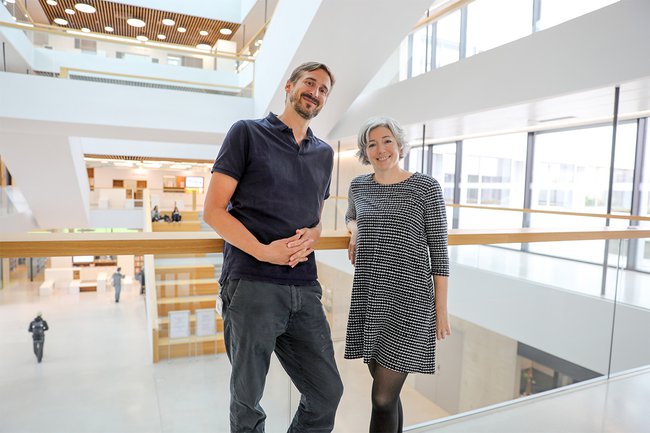In-Between Images
Analogue Animation Meets Virtual Reality in the UAS Research Project VRinMotion

The St. Pölten UAS’ research project VRinMotion explored how analogue stop-motion processes can be translated into virtual realities. In close partnership with international artists, the project has produced four experimental installations. Together, the project team developed artistic forms of expression in immersive space – with impressive results!
How can traditional stop-motion techniques and experimental forms of animations be adapted for virtual reality? This is the question posed by the research project VRinMotion at the Institute for Creative\Media/Technologies at the University of Applied Sciences St. Pölten. For three years, the team of international researchers worked alongside international guest artists to explore how physical materials, puppeteering, and digital technologies can bring about new aesthetic forms of expression in immersive environments. Through this work, the research team made an important contribution to the global discourse on animation in immersive media.
“Thanks to VRinMotion, we succeeded in weaving together analogue stop-motion aesthetics and digital immersion. The output demonstrates how artistic research can substantially contribute to rethinking virtual space, not just technologically, but also in terms of aesthetic and sensory experience”, highlights Franziska Proksa, project lead and interim Head of the Institute of Creative\Media/Technologies at the St. Pölten UAS.
New Forms of Artistic Research
The focus was placed on the development of artistic test labs and installations – the so-called ExperiMotions. These ranged from the integration of cut-out animations within virtual reality (VR), to experimental puppeteering with kinetic objects, and hybrid installations that blend physical and virtual components.
Rethinking Historical Media
The project set great store by including pre-cinematic concepts into immersive environments. In collaboration with Greek-Austrian media artist Anna Vasor, a series of work was created that combined the historical image-making devices with virtual reality. The short paper “Fragmenting Space and Time: Bridging Kinetic Sculptures and Pre-Cinematic Concepts for Virtual Reality” describes how a movable birdcage sculpture and its sequels – inspired by Étienne-Jules Marey’s chronophotography – were translated into VR.
Visitors were invited to experience the illusion of time unfolding in a linear fashion – and they, themselves, could become part of the experiment. The final outcome was the installation The Cage of Time, a unique fusion of a tangible object and virtual experience that received acclaim at both the Best Austrian Animation Festival in Vienna and the FILE Festival in São Paulo in 2024.
“By merging physical and digital worlds, The Cage of Time not only provides a captivating experience, it also makes people reflect on their own perception of reality and time”, explains Anna Vasof who accompanied ExperiMotion 3 as a guest artist.
Pixilation and VR: New Aestethics Emerges
In the fourth and final project phase, Franziska Proksa and her team worked with artists Paul Wenninger and Raul Maia to explore the integration of the traditional stop-motion technique pixilation into virtual reality. The short paper “Artistic Exploration of a Pixilated Choreography in Virtual Reality: Exploring 3D Gaussian Splatting for Stop-Motion Animation” documents how 35 synchronously activated cameras and a new technique called “3D Gaussian Splatting” were used to animate live performers. The results opened new possibilities for VR narrations: By combining miniature and life-sized fragmented movement with tangible aesthetics, the team developed a completely novel form of expression in immersive space. Although still technically demanding, the method shows the potential of reimagining pixilation as an artistic technique for virtual reality.
“I was particularly fascinated by the need to abandon the filmic image composition I was accustomed to in VR”, shares Paul Wenninger, guest artist with ExperiMotion 4. “On the one hand, this made filming easier, on the other, it was quite a challenge to guide the audience’s attention towards the right direction without relying on traditional camera movement.”
AI-Generated vs Real Content
Although volumetric video recording remains technically demanding, the new methods demonstrate the potential for producing immersive experiences as well as traditional film.
“In a time when cinematic discourse is largely dominated by AI-generated content, we were able to point towards a way in which real content can be made accessible in the immersive films of the future,” emphasises Matthias Husinsky, Professor at the Department of Media and Digital Technologies at St. Pölten University of Applied Sciences and Technical Director of VRinMotion. “Without artistic experimentation in the context of technological development, it would not be possible to explore the creative scope and challenges of these new production methods.”
International Visibility
In addition to international conference contributions and publications, the research team has showcased VRinMotion at numerous festivals and symposia – including Ars Electronica in Linz, Animafest Zagrem, and the Best Austrian Animation Festival. All in all, the team of VRinMotion has not only tested new artistic tools, but also made a major contribution to the global discourse on animation in immersive media.
VRinMotion at Forschungsfest NÖ 2025
St. Pölten UAS Researchers and artist Paul Wenninger will present a VRinMotion installation at this year’s Forschungsfest Niederösterreich – the Lower Austrian research festival. Visitors can directly dive into a pixilated virtual experience, thereby challenging conventional perceptions of reality, space, and time. At the same time, they can find out more about the background and the development process of the installation.
Forschungsfest Niederösterreich is an event for the entire family. Everybody who is interested is invited to engage in direct contact with science and research.
When: 10/10/2025, 13:00-21:00
Where: Palais Niederösterreich, Herrengasse 13, 1010 Vienna
Entrance free!
About VRinMotion
VRinMotion is funded by the Austrian Science Fund (FWF).
- For more information about the project, visit our website.
- ▶️ Watch videos of individual ExperiMotions on the project’s YouTube channel.
- 🎙️Campus Talk – The St. Pölten UAS’ Podcast: “Animation and VR? New rooms, new perspectives!” with Franziska Proksa and Matthias Husinsky: Listen to the podcast (German)
Right to Award Doctoral Degrees for Universities of Applied Sciences
The Austrian University of Applied Sciences Conference calls for the right to award doctoral degrees for universities of applied sciences in Austria. St. Pölten University of Applied Sciences supports this demand.
The research field of Media and Digital Technologies is exceptionally well established at St. Pölten UAS and has been significantly expanded over recent years. For St. Pölten UAS, it is important to gain the opportunity to offer independent doctoral programmes in this area. Universities of applied sciences are closely connected with businesses and regional structures. Doctoral candidates drive forward key technologies and innovations that flow into the economy, industry, and SMEs. Regions benefit from stronger local ties, while companies profit from practice-oriented research.

FH-Prof. Mag. Mag. Dr. Franziska Proksa
Interim Head of Research InstituteInstitute of Creative\Media/Technologies Head of
Media Creation Research Group
Institute of Creative\Media/Technologies Senior Researcher
Media Creation Research Group
Institute of Creative\Media/Technologies Department of Media and Digital Technologies
